LIDL: Operations and Logistics Management Report on Process Design
VerifiedAdded on 2020/02/03
|9
|2909
|213
Report
AI Summary
This report provides an in-depth analysis of LIDL's operations and logistics management, with a specific focus on process design within the context of its electronic product offerings. It begins with an introduction to operations and logistics management, highlighting their importance in delivering goods and services efficiently. The report then introduces LIDL, a German global supermarket chain, and its competitive landscape. The core of the report examines LIDL's product and service offerings, particularly its electronic product segment, and the role of process design in launching new products. It outlines the aims and objectives of product development using process design, including market expansion and brand building. The report also details the stages of product development, from concept identification to decision-making, and discusses the impact of performance objectives on design. The report highlights the importance of market analysis, data collection, and strategic decision-making in the context of process design. The conclusion reinforces the importance of effective operations and logistics management for LIDL's success in the competitive retail market.
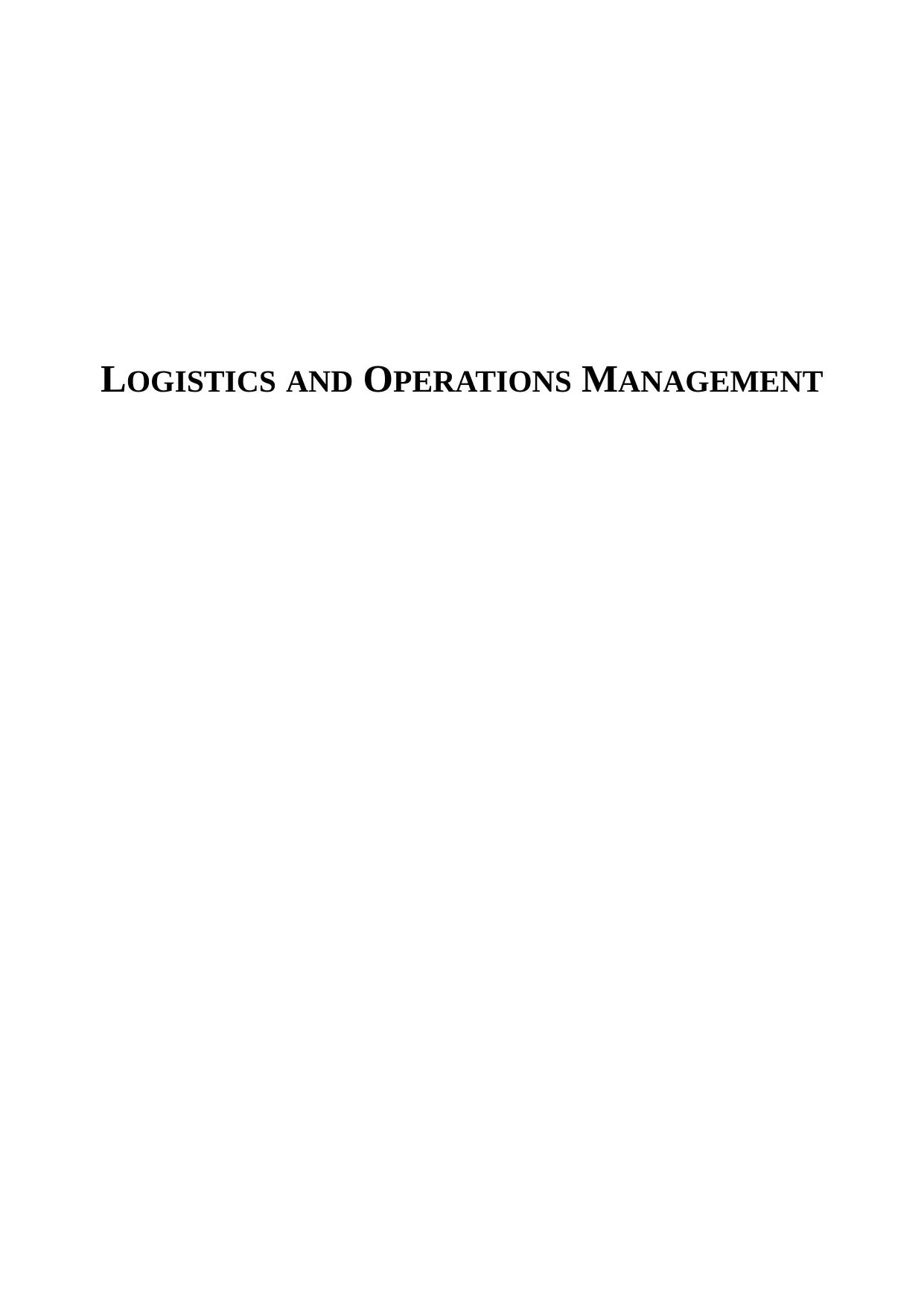
LOGISTICS AND OPERATIONS MANAGEMENT
Paraphrase This Document
Need a fresh take? Get an instant paraphrase of this document with our AI Paraphraser
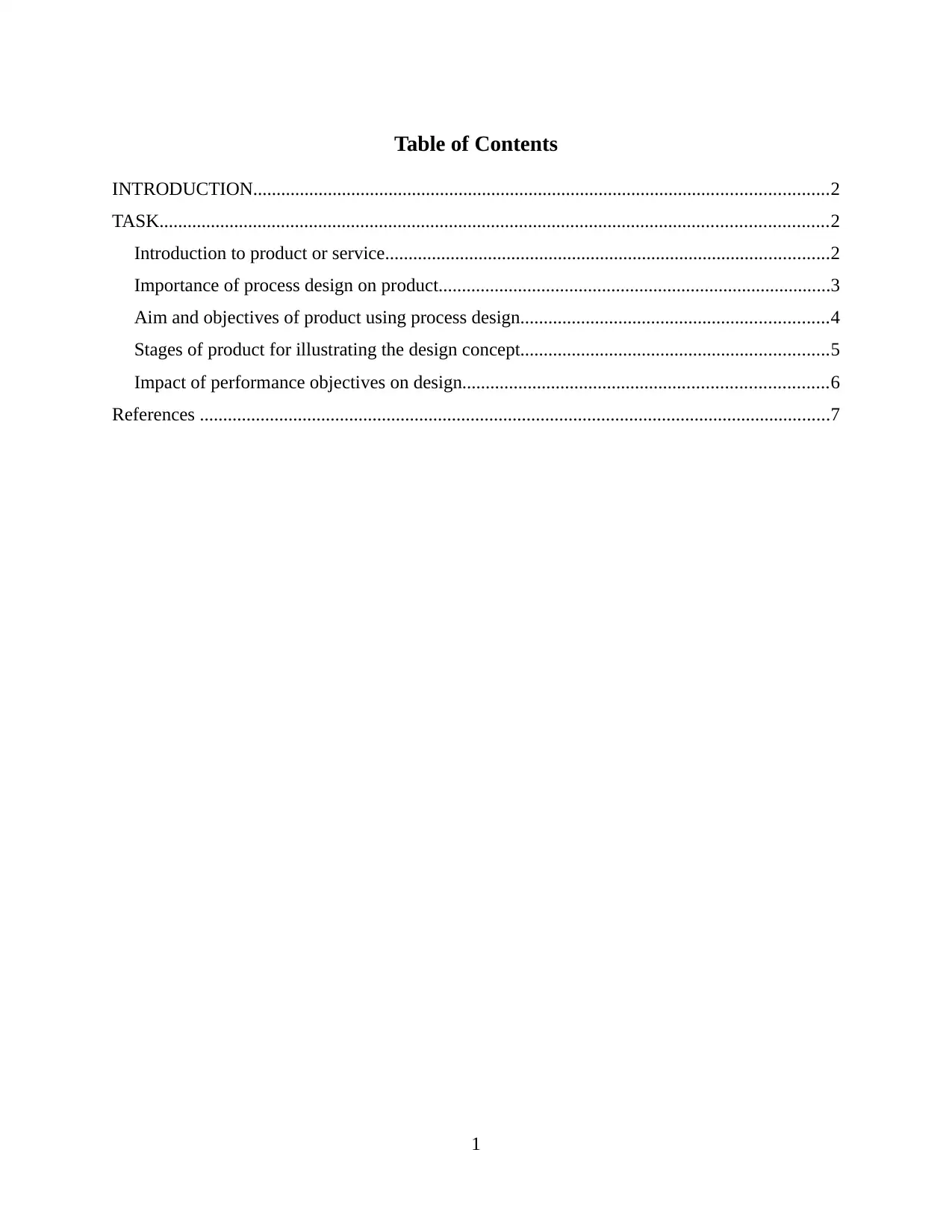
Table of Contents
INTRODUCTION...........................................................................................................................2
TASK...............................................................................................................................................2
Introduction to product or service...............................................................................................2
Importance of process design on product....................................................................................3
Aim and objectives of product using process design..................................................................4
Stages of product for illustrating the design concept..................................................................5
Impact of performance objectives on design..............................................................................6
References .......................................................................................................................................7
1
INTRODUCTION...........................................................................................................................2
TASK...............................................................................................................................................2
Introduction to product or service...............................................................................................2
Importance of process design on product....................................................................................3
Aim and objectives of product using process design..................................................................4
Stages of product for illustrating the design concept..................................................................5
Impact of performance objectives on design..............................................................................6
References .......................................................................................................................................7
1
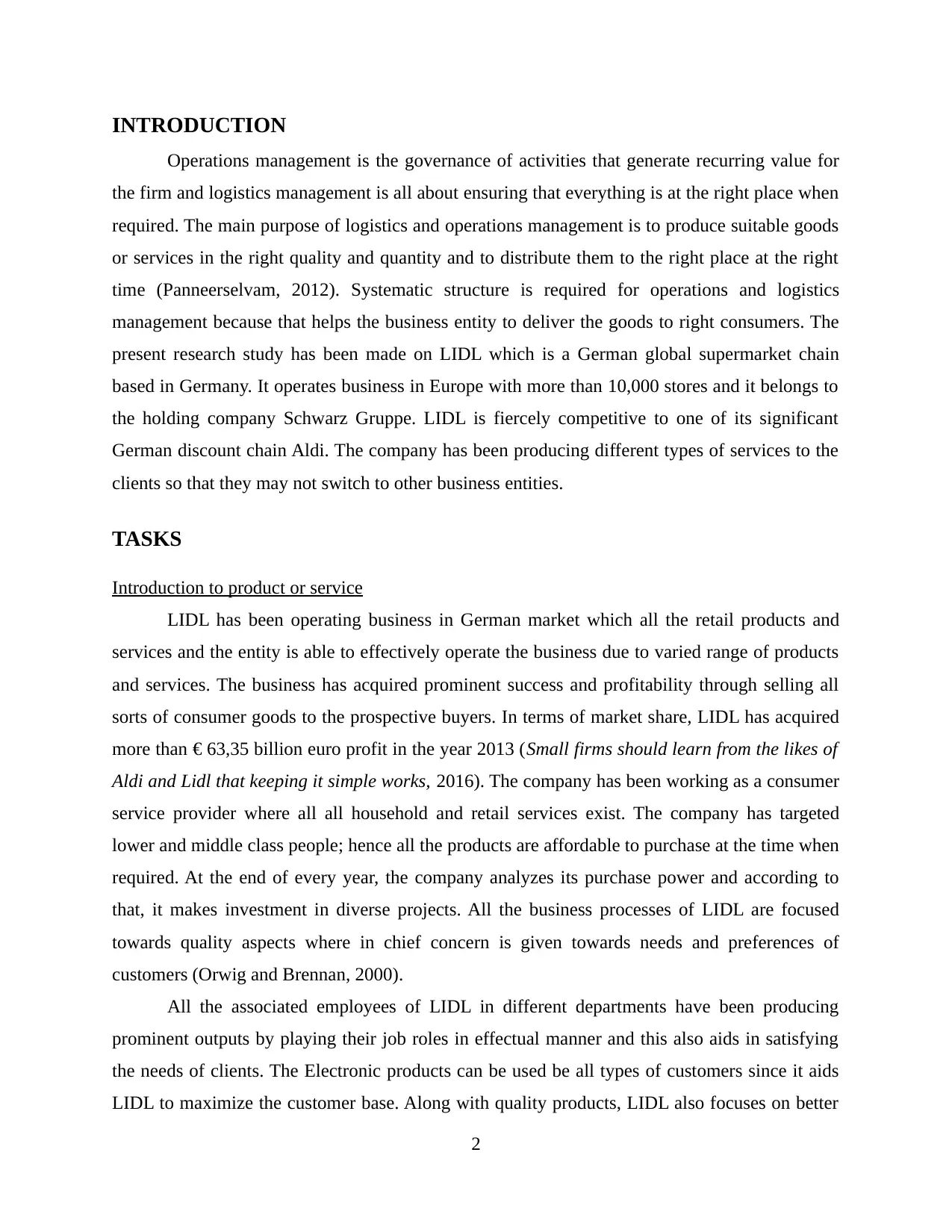
INTRODUCTION
Operations management is the governance of activities that generate recurring value for
the firm and logistics management is all about ensuring that everything is at the right place when
required. The main purpose of logistics and operations management is to produce suitable goods
or services in the right quality and quantity and to distribute them to the right place at the right
time (Panneerselvam, 2012). Systematic structure is required for operations and logistics
management because that helps the business entity to deliver the goods to right consumers. The
present research study has been made on LIDL which is a German global supermarket chain
based in Germany. It operates business in Europe with more than 10,000 stores and it belongs to
the holding company Schwarz Gruppe. LIDL is fiercely competitive to one of its significant
German discount chain Aldi. The company has been producing different types of services to the
clients so that they may not switch to other business entities.
TASKS
Introduction to product or service
LIDL has been operating business in German market which all the retail products and
services and the entity is able to effectively operate the business due to varied range of products
and services. The business has acquired prominent success and profitability through selling all
sorts of consumer goods to the prospective buyers. In terms of market share, LIDL has acquired
more than € 63,35 billion euro profit in the year 2013 (Small firms should learn from the likes of
Aldi and Lidl that keeping it simple works, 2016). The company has been working as a consumer
service provider where all all household and retail services exist. The company has targeted
lower and middle class people; hence all the products are affordable to purchase at the time when
required. At the end of every year, the company analyzes its purchase power and according to
that, it makes investment in diverse projects. All the business processes of LIDL are focused
towards quality aspects where in chief concern is given towards needs and preferences of
customers (Orwig and Brennan, 2000).
All the associated employees of LIDL in different departments have been producing
prominent outputs by playing their job roles in effectual manner and this also aids in satisfying
the needs of clients. The Electronic products can be used be all types of customers since it aids
LIDL to maximize the customer base. Along with quality products, LIDL also focuses on better
2
Operations management is the governance of activities that generate recurring value for
the firm and logistics management is all about ensuring that everything is at the right place when
required. The main purpose of logistics and operations management is to produce suitable goods
or services in the right quality and quantity and to distribute them to the right place at the right
time (Panneerselvam, 2012). Systematic structure is required for operations and logistics
management because that helps the business entity to deliver the goods to right consumers. The
present research study has been made on LIDL which is a German global supermarket chain
based in Germany. It operates business in Europe with more than 10,000 stores and it belongs to
the holding company Schwarz Gruppe. LIDL is fiercely competitive to one of its significant
German discount chain Aldi. The company has been producing different types of services to the
clients so that they may not switch to other business entities.
TASKS
Introduction to product or service
LIDL has been operating business in German market which all the retail products and
services and the entity is able to effectively operate the business due to varied range of products
and services. The business has acquired prominent success and profitability through selling all
sorts of consumer goods to the prospective buyers. In terms of market share, LIDL has acquired
more than € 63,35 billion euro profit in the year 2013 (Small firms should learn from the likes of
Aldi and Lidl that keeping it simple works, 2016). The company has been working as a consumer
service provider where all all household and retail services exist. The company has targeted
lower and middle class people; hence all the products are affordable to purchase at the time when
required. At the end of every year, the company analyzes its purchase power and according to
that, it makes investment in diverse projects. All the business processes of LIDL are focused
towards quality aspects where in chief concern is given towards needs and preferences of
customers (Orwig and Brennan, 2000).
All the associated employees of LIDL in different departments have been producing
prominent outputs by playing their job roles in effectual manner and this also aids in satisfying
the needs of clients. The Electronic products can be used be all types of customers since it aids
LIDL to maximize the customer base. Along with quality products, LIDL also focuses on better
2
⊘ This is a preview!⊘
Do you want full access?
Subscribe today to unlock all pages.

Trusted by 1+ million students worldwide
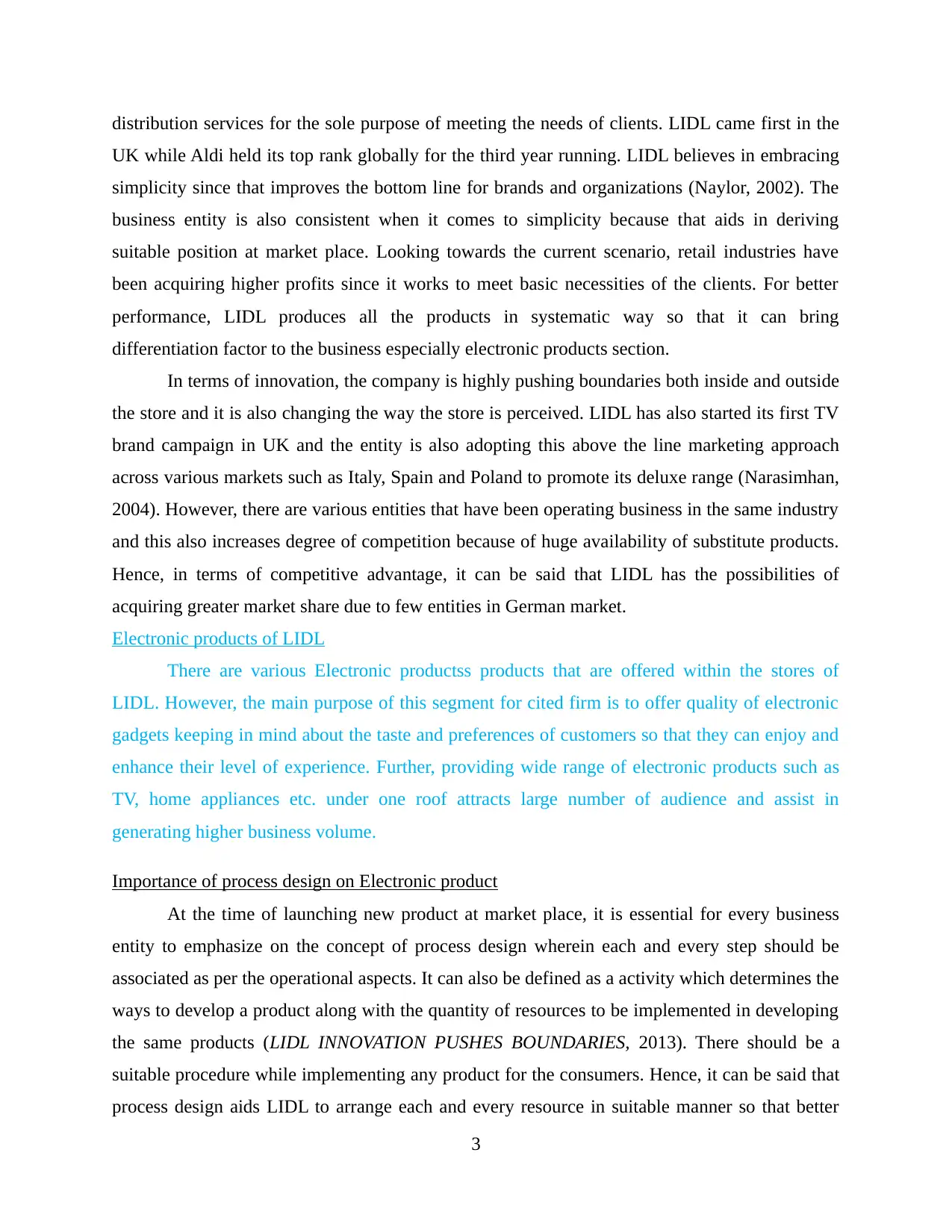
distribution services for the sole purpose of meeting the needs of clients. LIDL came first in the
UK while Aldi held its top rank globally for the third year running. LIDL believes in embracing
simplicity since that improves the bottom line for brands and organizations (Naylor, 2002). The
business entity is also consistent when it comes to simplicity because that aids in deriving
suitable position at market place. Looking towards the current scenario, retail industries have
been acquiring higher profits since it works to meet basic necessities of the clients. For better
performance, LIDL produces all the products in systematic way so that it can bring
differentiation factor to the business especially electronic products section.
In terms of innovation, the company is highly pushing boundaries both inside and outside
the store and it is also changing the way the store is perceived. LIDL has also started its first TV
brand campaign in UK and the entity is also adopting this above the line marketing approach
across various markets such as Italy, Spain and Poland to promote its deluxe range (Narasimhan,
2004). However, there are various entities that have been operating business in the same industry
and this also increases degree of competition because of huge availability of substitute products.
Hence, in terms of competitive advantage, it can be said that LIDL has the possibilities of
acquiring greater market share due to few entities in German market.
Electronic products of LIDL
There are various Electronic productss products that are offered within the stores of
LIDL. However, the main purpose of this segment for cited firm is to offer quality of electronic
gadgets keeping in mind about the taste and preferences of customers so that they can enjoy and
enhance their level of experience. Further, providing wide range of electronic products such as
TV, home appliances etc. under one roof attracts large number of audience and assist in
generating higher business volume.
Importance of process design on Electronic product
At the time of launching new product at market place, it is essential for every business
entity to emphasize on the concept of process design wherein each and every step should be
associated as per the operational aspects. It can also be defined as a activity which determines the
ways to develop a product along with the quantity of resources to be implemented in developing
the same products (LIDL INNOVATION PUSHES BOUNDARIES, 2013). There should be a
suitable procedure while implementing any product for the consumers. Hence, it can be said that
process design aids LIDL to arrange each and every resource in suitable manner so that better
3
UK while Aldi held its top rank globally for the third year running. LIDL believes in embracing
simplicity since that improves the bottom line for brands and organizations (Naylor, 2002). The
business entity is also consistent when it comes to simplicity because that aids in deriving
suitable position at market place. Looking towards the current scenario, retail industries have
been acquiring higher profits since it works to meet basic necessities of the clients. For better
performance, LIDL produces all the products in systematic way so that it can bring
differentiation factor to the business especially electronic products section.
In terms of innovation, the company is highly pushing boundaries both inside and outside
the store and it is also changing the way the store is perceived. LIDL has also started its first TV
brand campaign in UK and the entity is also adopting this above the line marketing approach
across various markets such as Italy, Spain and Poland to promote its deluxe range (Narasimhan,
2004). However, there are various entities that have been operating business in the same industry
and this also increases degree of competition because of huge availability of substitute products.
Hence, in terms of competitive advantage, it can be said that LIDL has the possibilities of
acquiring greater market share due to few entities in German market.
Electronic products of LIDL
There are various Electronic productss products that are offered within the stores of
LIDL. However, the main purpose of this segment for cited firm is to offer quality of electronic
gadgets keeping in mind about the taste and preferences of customers so that they can enjoy and
enhance their level of experience. Further, providing wide range of electronic products such as
TV, home appliances etc. under one roof attracts large number of audience and assist in
generating higher business volume.
Importance of process design on Electronic product
At the time of launching new product at market place, it is essential for every business
entity to emphasize on the concept of process design wherein each and every step should be
associated as per the operational aspects. It can also be defined as a activity which determines the
ways to develop a product along with the quantity of resources to be implemented in developing
the same products (LIDL INNOVATION PUSHES BOUNDARIES, 2013). There should be a
suitable procedure while implementing any product for the consumers. Hence, it can be said that
process design aids LIDL to arrange each and every resource in suitable manner so that better
3
Paraphrase This Document
Need a fresh take? Get an instant paraphrase of this document with our AI Paraphraser
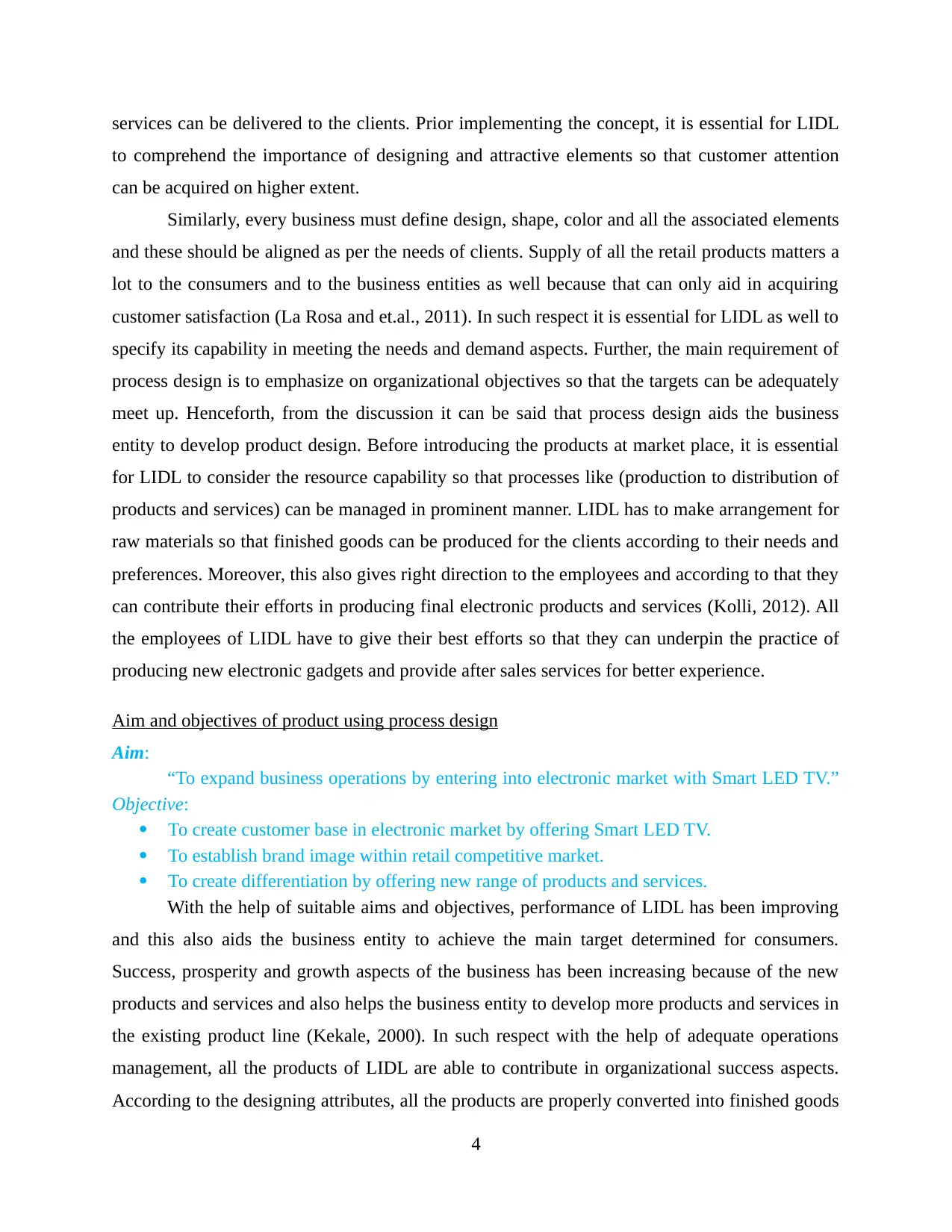
services can be delivered to the clients. Prior implementing the concept, it is essential for LIDL
to comprehend the importance of designing and attractive elements so that customer attention
can be acquired on higher extent.
Similarly, every business must define design, shape, color and all the associated elements
and these should be aligned as per the needs of clients. Supply of all the retail products matters a
lot to the consumers and to the business entities as well because that can only aid in acquiring
customer satisfaction (La Rosa and et.al., 2011). In such respect it is essential for LIDL as well to
specify its capability in meeting the needs and demand aspects. Further, the main requirement of
process design is to emphasize on organizational objectives so that the targets can be adequately
meet up. Henceforth, from the discussion it can be said that process design aids the business
entity to develop product design. Before introducing the products at market place, it is essential
for LIDL to consider the resource capability so that processes like (production to distribution of
products and services) can be managed in prominent manner. LIDL has to make arrangement for
raw materials so that finished goods can be produced for the clients according to their needs and
preferences. Moreover, this also gives right direction to the employees and according to that they
can contribute their efforts in producing final electronic products and services (Kolli, 2012). All
the employees of LIDL have to give their best efforts so that they can underpin the practice of
producing new electronic gadgets and provide after sales services for better experience.
Aim and objectives of product using process design
Aim:
“To expand business operations by entering into electronic market with Smart LED TV.”
Objective:
To create customer base in electronic market by offering Smart LED TV.
To establish brand image within retail competitive market.
To create differentiation by offering new range of products and services.
With the help of suitable aims and objectives, performance of LIDL has been improving
and this also aids the business entity to achieve the main target determined for consumers.
Success, prosperity and growth aspects of the business has been increasing because of the new
products and services and also helps the business entity to develop more products and services in
the existing product line (Kekale, 2000). In such respect with the help of adequate operations
management, all the products of LIDL are able to contribute in organizational success aspects.
According to the designing attributes, all the products are properly converted into finished goods
4
to comprehend the importance of designing and attractive elements so that customer attention
can be acquired on higher extent.
Similarly, every business must define design, shape, color and all the associated elements
and these should be aligned as per the needs of clients. Supply of all the retail products matters a
lot to the consumers and to the business entities as well because that can only aid in acquiring
customer satisfaction (La Rosa and et.al., 2011). In such respect it is essential for LIDL as well to
specify its capability in meeting the needs and demand aspects. Further, the main requirement of
process design is to emphasize on organizational objectives so that the targets can be adequately
meet up. Henceforth, from the discussion it can be said that process design aids the business
entity to develop product design. Before introducing the products at market place, it is essential
for LIDL to consider the resource capability so that processes like (production to distribution of
products and services) can be managed in prominent manner. LIDL has to make arrangement for
raw materials so that finished goods can be produced for the clients according to their needs and
preferences. Moreover, this also gives right direction to the employees and according to that they
can contribute their efforts in producing final electronic products and services (Kolli, 2012). All
the employees of LIDL have to give their best efforts so that they can underpin the practice of
producing new electronic gadgets and provide after sales services for better experience.
Aim and objectives of product using process design
Aim:
“To expand business operations by entering into electronic market with Smart LED TV.”
Objective:
To create customer base in electronic market by offering Smart LED TV.
To establish brand image within retail competitive market.
To create differentiation by offering new range of products and services.
With the help of suitable aims and objectives, performance of LIDL has been improving
and this also aids the business entity to achieve the main target determined for consumers.
Success, prosperity and growth aspects of the business has been increasing because of the new
products and services and also helps the business entity to develop more products and services in
the existing product line (Kekale, 2000). In such respect with the help of adequate operations
management, all the products of LIDL are able to contribute in organizational success aspects.
According to the designing attributes, all the products are properly converted into finished goods
4
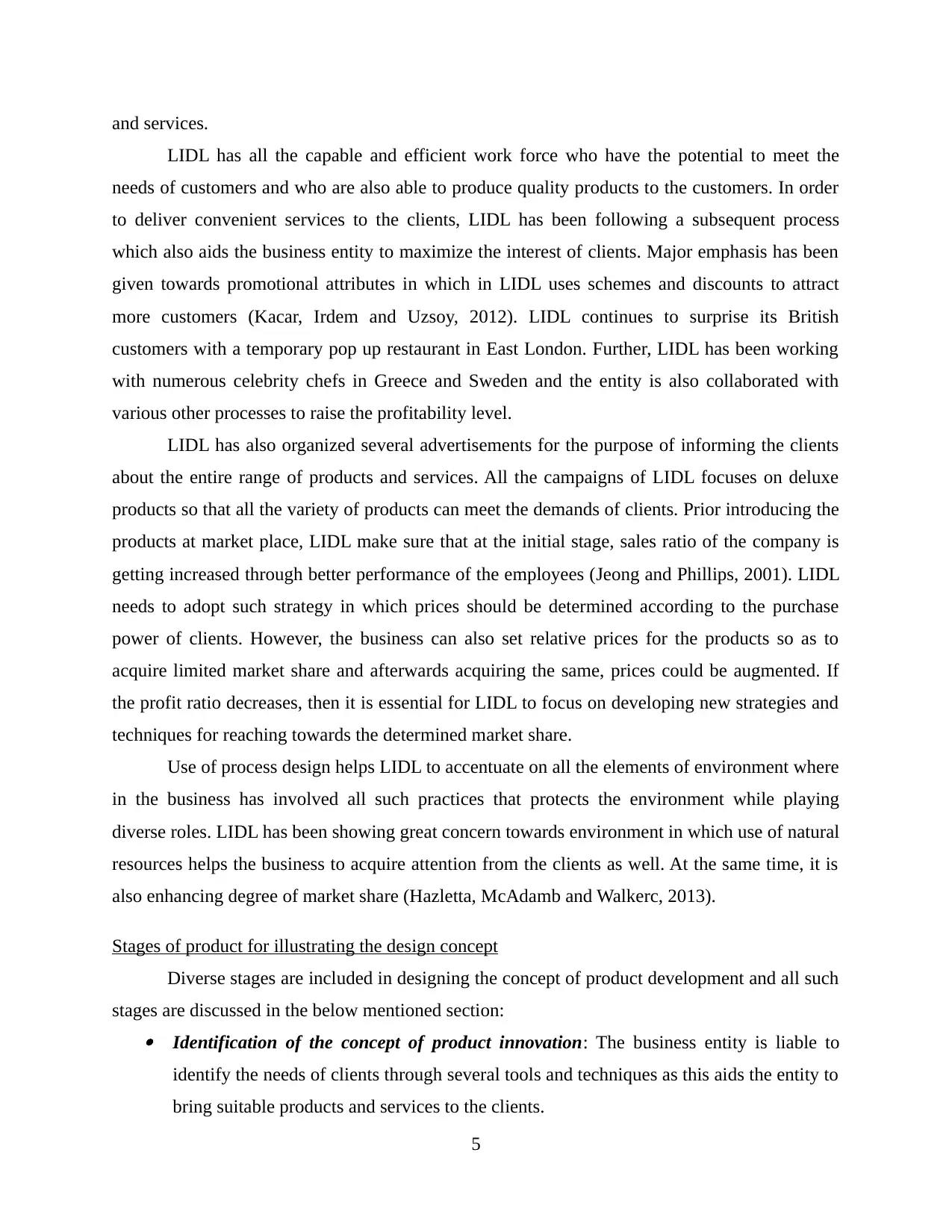
and services.
LIDL has all the capable and efficient work force who have the potential to meet the
needs of customers and who are also able to produce quality products to the customers. In order
to deliver convenient services to the clients, LIDL has been following a subsequent process
which also aids the business entity to maximize the interest of clients. Major emphasis has been
given towards promotional attributes in which in LIDL uses schemes and discounts to attract
more customers (Kacar, Irdem and Uzsoy, 2012). LIDL continues to surprise its British
customers with a temporary pop up restaurant in East London. Further, LIDL has been working
with numerous celebrity chefs in Greece and Sweden and the entity is also collaborated with
various other processes to raise the profitability level.
LIDL has also organized several advertisements for the purpose of informing the clients
about the entire range of products and services. All the campaigns of LIDL focuses on deluxe
products so that all the variety of products can meet the demands of clients. Prior introducing the
products at market place, LIDL make sure that at the initial stage, sales ratio of the company is
getting increased through better performance of the employees (Jeong and Phillips, 2001). LIDL
needs to adopt such strategy in which prices should be determined according to the purchase
power of clients. However, the business can also set relative prices for the products so as to
acquire limited market share and afterwards acquiring the same, prices could be augmented. If
the profit ratio decreases, then it is essential for LIDL to focus on developing new strategies and
techniques for reaching towards the determined market share.
Use of process design helps LIDL to accentuate on all the elements of environment where
in the business has involved all such practices that protects the environment while playing
diverse roles. LIDL has been showing great concern towards environment in which use of natural
resources helps the business to acquire attention from the clients as well. At the same time, it is
also enhancing degree of market share (Hazletta, McAdamb and Walkerc, 2013).
Stages of product for illustrating the design concept
Diverse stages are included in designing the concept of product development and all such
stages are discussed in the below mentioned section: Identification of the concept of product innovation: The business entity is liable to
identify the needs of clients through several tools and techniques as this aids the entity to
bring suitable products and services to the clients.
5
LIDL has all the capable and efficient work force who have the potential to meet the
needs of customers and who are also able to produce quality products to the customers. In order
to deliver convenient services to the clients, LIDL has been following a subsequent process
which also aids the business entity to maximize the interest of clients. Major emphasis has been
given towards promotional attributes in which in LIDL uses schemes and discounts to attract
more customers (Kacar, Irdem and Uzsoy, 2012). LIDL continues to surprise its British
customers with a temporary pop up restaurant in East London. Further, LIDL has been working
with numerous celebrity chefs in Greece and Sweden and the entity is also collaborated with
various other processes to raise the profitability level.
LIDL has also organized several advertisements for the purpose of informing the clients
about the entire range of products and services. All the campaigns of LIDL focuses on deluxe
products so that all the variety of products can meet the demands of clients. Prior introducing the
products at market place, LIDL make sure that at the initial stage, sales ratio of the company is
getting increased through better performance of the employees (Jeong and Phillips, 2001). LIDL
needs to adopt such strategy in which prices should be determined according to the purchase
power of clients. However, the business can also set relative prices for the products so as to
acquire limited market share and afterwards acquiring the same, prices could be augmented. If
the profit ratio decreases, then it is essential for LIDL to focus on developing new strategies and
techniques for reaching towards the determined market share.
Use of process design helps LIDL to accentuate on all the elements of environment where
in the business has involved all such practices that protects the environment while playing
diverse roles. LIDL has been showing great concern towards environment in which use of natural
resources helps the business to acquire attention from the clients as well. At the same time, it is
also enhancing degree of market share (Hazletta, McAdamb and Walkerc, 2013).
Stages of product for illustrating the design concept
Diverse stages are included in designing the concept of product development and all such
stages are discussed in the below mentioned section: Identification of the concept of product innovation: The business entity is liable to
identify the needs of clients through several tools and techniques as this aids the entity to
bring suitable products and services to the clients.
5
⊘ This is a preview!⊘
Do you want full access?
Subscribe today to unlock all pages.

Trusted by 1+ million students worldwide
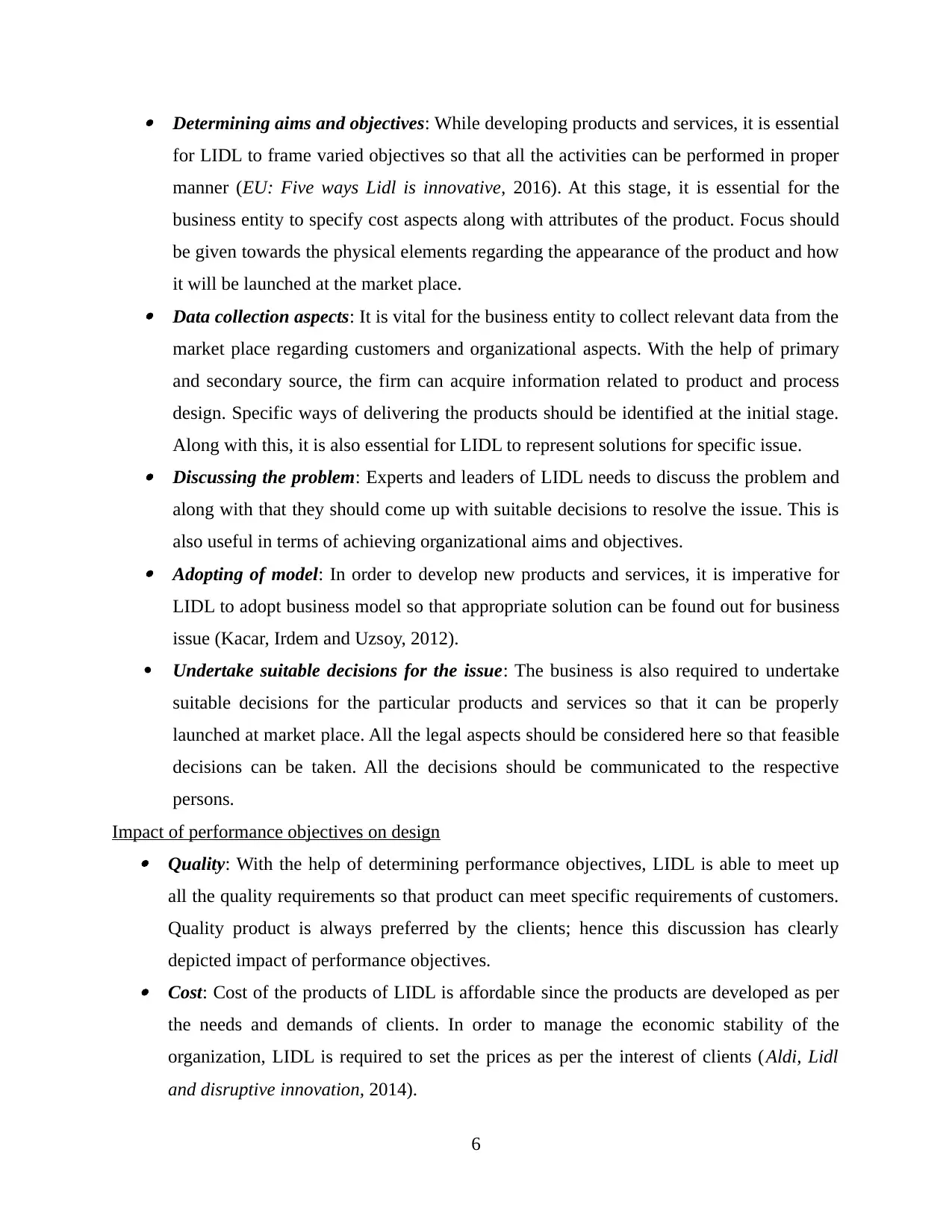
Determining aims and objectives: While developing products and services, it is essential
for LIDL to frame varied objectives so that all the activities can be performed in proper
manner (EU: Five ways Lidl is innovative, 2016). At this stage, it is essential for the
business entity to specify cost aspects along with attributes of the product. Focus should
be given towards the physical elements regarding the appearance of the product and how
it will be launched at the market place. Data collection aspects: It is vital for the business entity to collect relevant data from the
market place regarding customers and organizational aspects. With the help of primary
and secondary source, the firm can acquire information related to product and process
design. Specific ways of delivering the products should be identified at the initial stage.
Along with this, it is also essential for LIDL to represent solutions for specific issue. Discussing the problem: Experts and leaders of LIDL needs to discuss the problem and
along with that they should come up with suitable decisions to resolve the issue. This is
also useful in terms of achieving organizational aims and objectives. Adopting of model: In order to develop new products and services, it is imperative for
LIDL to adopt business model so that appropriate solution can be found out for business
issue (Kacar, Irdem and Uzsoy, 2012).
Undertake suitable decisions for the issue: The business is also required to undertake
suitable decisions for the particular products and services so that it can be properly
launched at market place. All the legal aspects should be considered here so that feasible
decisions can be taken. All the decisions should be communicated to the respective
persons.
Impact of performance objectives on design Quality: With the help of determining performance objectives, LIDL is able to meet up
all the quality requirements so that product can meet specific requirements of customers.
Quality product is always preferred by the clients; hence this discussion has clearly
depicted impact of performance objectives. Cost: Cost of the products of LIDL is affordable since the products are developed as per
the needs and demands of clients. In order to manage the economic stability of the
organization, LIDL is required to set the prices as per the interest of clients (Aldi, Lidl
and disruptive innovation, 2014).
6
for LIDL to frame varied objectives so that all the activities can be performed in proper
manner (EU: Five ways Lidl is innovative, 2016). At this stage, it is essential for the
business entity to specify cost aspects along with attributes of the product. Focus should
be given towards the physical elements regarding the appearance of the product and how
it will be launched at the market place. Data collection aspects: It is vital for the business entity to collect relevant data from the
market place regarding customers and organizational aspects. With the help of primary
and secondary source, the firm can acquire information related to product and process
design. Specific ways of delivering the products should be identified at the initial stage.
Along with this, it is also essential for LIDL to represent solutions for specific issue. Discussing the problem: Experts and leaders of LIDL needs to discuss the problem and
along with that they should come up with suitable decisions to resolve the issue. This is
also useful in terms of achieving organizational aims and objectives. Adopting of model: In order to develop new products and services, it is imperative for
LIDL to adopt business model so that appropriate solution can be found out for business
issue (Kacar, Irdem and Uzsoy, 2012).
Undertake suitable decisions for the issue: The business is also required to undertake
suitable decisions for the particular products and services so that it can be properly
launched at market place. All the legal aspects should be considered here so that feasible
decisions can be taken. All the decisions should be communicated to the respective
persons.
Impact of performance objectives on design Quality: With the help of determining performance objectives, LIDL is able to meet up
all the quality requirements so that product can meet specific requirements of customers.
Quality product is always preferred by the clients; hence this discussion has clearly
depicted impact of performance objectives. Cost: Cost of the products of LIDL is affordable since the products are developed as per
the needs and demands of clients. In order to manage the economic stability of the
organization, LIDL is required to set the prices as per the interest of clients (Aldi, Lidl
and disruptive innovation, 2014).
6
Paraphrase This Document
Need a fresh take? Get an instant paraphrase of this document with our AI Paraphraser
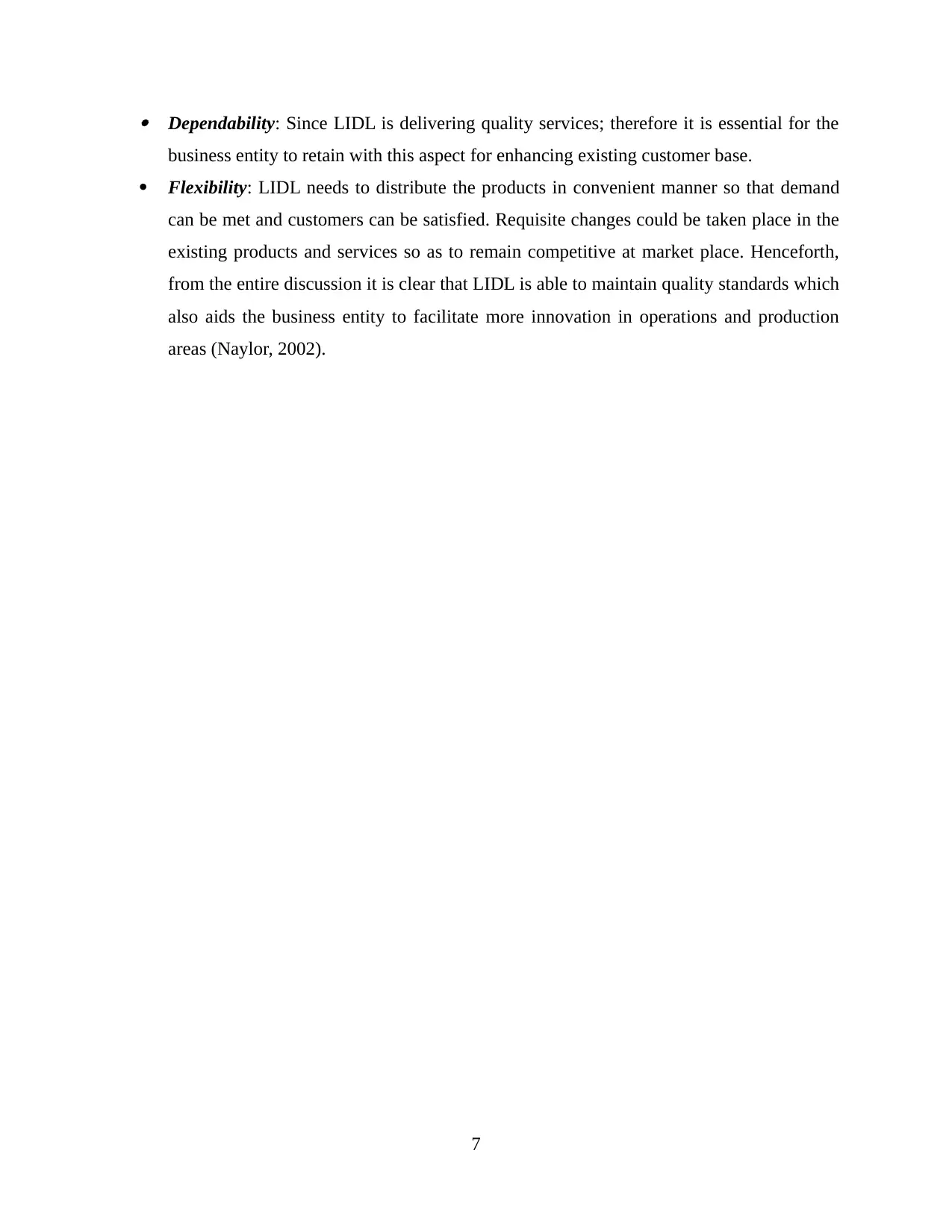
Dependability: Since LIDL is delivering quality services; therefore it is essential for the
business entity to retain with this aspect for enhancing existing customer base.
Flexibility: LIDL needs to distribute the products in convenient manner so that demand
can be met and customers can be satisfied. Requisite changes could be taken place in the
existing products and services so as to remain competitive at market place. Henceforth,
from the entire discussion it is clear that LIDL is able to maintain quality standards which
also aids the business entity to facilitate more innovation in operations and production
areas (Naylor, 2002).
7
business entity to retain with this aspect for enhancing existing customer base.
Flexibility: LIDL needs to distribute the products in convenient manner so that demand
can be met and customers can be satisfied. Requisite changes could be taken place in the
existing products and services so as to remain competitive at market place. Henceforth,
from the entire discussion it is clear that LIDL is able to maintain quality standards which
also aids the business entity to facilitate more innovation in operations and production
areas (Naylor, 2002).
7
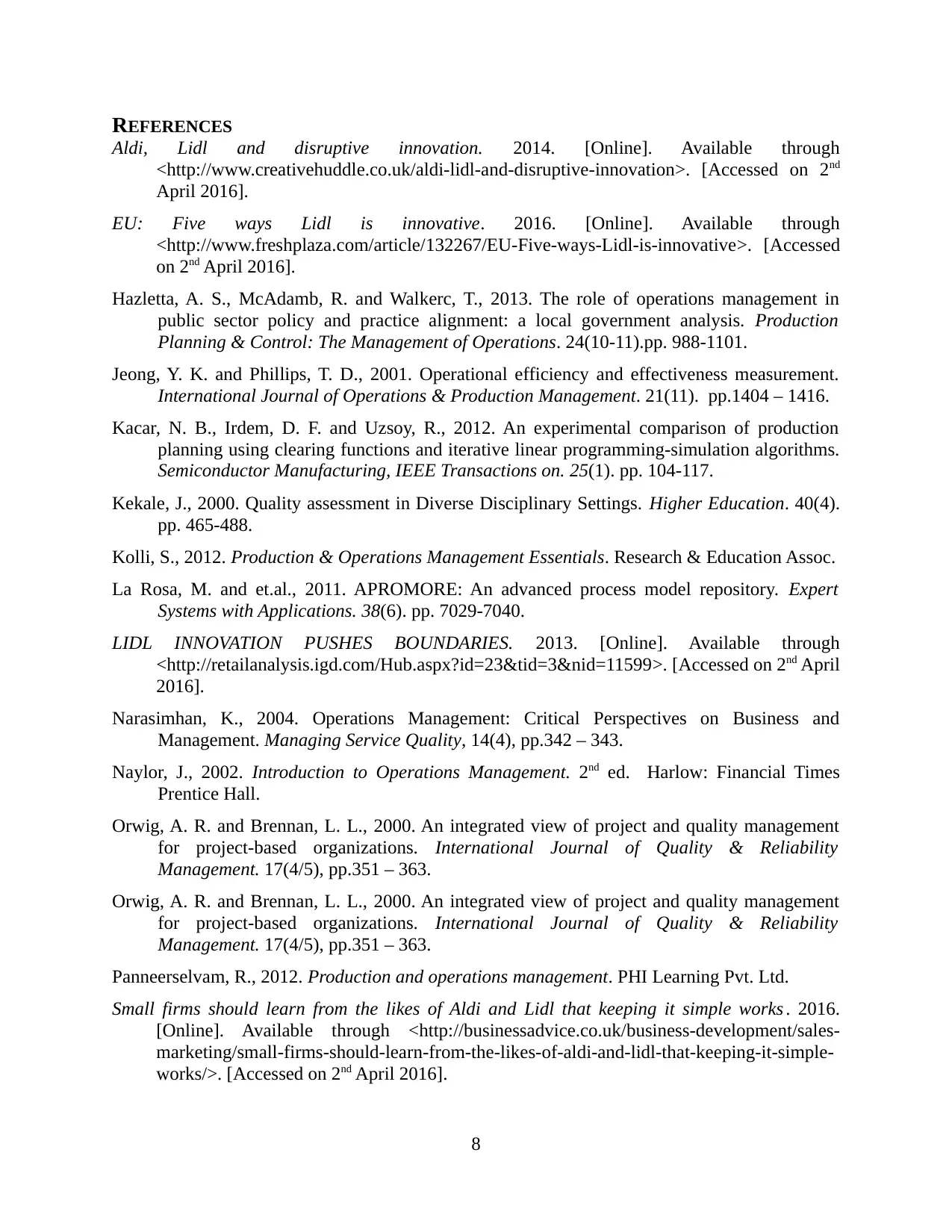
REFERENCES
Aldi, Lidl and disruptive innovation. 2014. [Online]. Available through
<http://www.creativehuddle.co.uk/aldi-lidl-and-disruptive-innovation>. [Accessed on 2nd
April 2016].
EU: Five ways Lidl is innovative. 2016. [Online]. Available through
<http://www.freshplaza.com/article/132267/EU-Five-ways-Lidl-is-innovative>. [Accessed
on 2nd April 2016].
Hazletta, A. S., McAdamb, R. and Walkerc, T., 2013. The role of operations management in
public sector policy and practice alignment: a local government analysis. Production
Planning & Control: The Management of Operations. 24(10-11).pp. 988-1101.
Jeong, Y. K. and Phillips, T. D., 2001. Operational efficiency and effectiveness measurement.
International Journal of Operations & Production Management. 21(11). pp.1404 – 1416.
Kacar, N. B., Irdem, D. F. and Uzsoy, R., 2012. An experimental comparison of production
planning using clearing functions and iterative linear programming-simulation algorithms.
Semiconductor Manufacturing, IEEE Transactions on. 25(1). pp. 104-117.
Kekale, J., 2000. Quality assessment in Diverse Disciplinary Settings. Higher Education. 40(4).
pp. 465-488.
Kolli, S., 2012. Production & Operations Management Essentials. Research & Education Assoc.
La Rosa, M. and et.al., 2011. APROMORE: An advanced process model repository. Expert
Systems with Applications. 38(6). pp. 7029-7040.
LIDL INNOVATION PUSHES BOUNDARIES. 2013. [Online]. Available through
<http://retailanalysis.igd.com/Hub.aspx?id=23&tid=3&nid=11599>. [Accessed on 2nd April
2016].
Narasimhan, K., 2004. Operations Management: Critical Perspectives on Business and
Management. Managing Service Quality, 14(4), pp.342 – 343.
Naylor, J., 2002. Introduction to Operations Management. 2nd ed. Harlow: Financial Times
Prentice Hall.
Orwig, A. R. and Brennan, L. L., 2000. An integrated view of project and quality management
for project-based organizations. International Journal of Quality & Reliability
Management. 17(4/5), pp.351 – 363.
Orwig, A. R. and Brennan, L. L., 2000. An integrated view of project and quality management
for project-based organizations. International Journal of Quality & Reliability
Management. 17(4/5), pp.351 – 363.
Panneerselvam, R., 2012. Production and operations management. PHI Learning Pvt. Ltd.
Small firms should learn from the likes of Aldi and Lidl that keeping it simple works . 2016.
[Online]. Available through <http://businessadvice.co.uk/business-development/sales-
marketing/small-firms-should-learn-from-the-likes-of-aldi-and-lidl-that-keeping-it-simple-
works/>. [Accessed on 2nd April 2016].
8
Aldi, Lidl and disruptive innovation. 2014. [Online]. Available through
<http://www.creativehuddle.co.uk/aldi-lidl-and-disruptive-innovation>. [Accessed on 2nd
April 2016].
EU: Five ways Lidl is innovative. 2016. [Online]. Available through
<http://www.freshplaza.com/article/132267/EU-Five-ways-Lidl-is-innovative>. [Accessed
on 2nd April 2016].
Hazletta, A. S., McAdamb, R. and Walkerc, T., 2013. The role of operations management in
public sector policy and practice alignment: a local government analysis. Production
Planning & Control: The Management of Operations. 24(10-11).pp. 988-1101.
Jeong, Y. K. and Phillips, T. D., 2001. Operational efficiency and effectiveness measurement.
International Journal of Operations & Production Management. 21(11). pp.1404 – 1416.
Kacar, N. B., Irdem, D. F. and Uzsoy, R., 2012. An experimental comparison of production
planning using clearing functions and iterative linear programming-simulation algorithms.
Semiconductor Manufacturing, IEEE Transactions on. 25(1). pp. 104-117.
Kekale, J., 2000. Quality assessment in Diverse Disciplinary Settings. Higher Education. 40(4).
pp. 465-488.
Kolli, S., 2012. Production & Operations Management Essentials. Research & Education Assoc.
La Rosa, M. and et.al., 2011. APROMORE: An advanced process model repository. Expert
Systems with Applications. 38(6). pp. 7029-7040.
LIDL INNOVATION PUSHES BOUNDARIES. 2013. [Online]. Available through
<http://retailanalysis.igd.com/Hub.aspx?id=23&tid=3&nid=11599>. [Accessed on 2nd April
2016].
Narasimhan, K., 2004. Operations Management: Critical Perspectives on Business and
Management. Managing Service Quality, 14(4), pp.342 – 343.
Naylor, J., 2002. Introduction to Operations Management. 2nd ed. Harlow: Financial Times
Prentice Hall.
Orwig, A. R. and Brennan, L. L., 2000. An integrated view of project and quality management
for project-based organizations. International Journal of Quality & Reliability
Management. 17(4/5), pp.351 – 363.
Orwig, A. R. and Brennan, L. L., 2000. An integrated view of project and quality management
for project-based organizations. International Journal of Quality & Reliability
Management. 17(4/5), pp.351 – 363.
Panneerselvam, R., 2012. Production and operations management. PHI Learning Pvt. Ltd.
Small firms should learn from the likes of Aldi and Lidl that keeping it simple works . 2016.
[Online]. Available through <http://businessadvice.co.uk/business-development/sales-
marketing/small-firms-should-learn-from-the-likes-of-aldi-and-lidl-that-keeping-it-simple-
works/>. [Accessed on 2nd April 2016].
8
⊘ This is a preview!⊘
Do you want full access?
Subscribe today to unlock all pages.

Trusted by 1+ million students worldwide
1 out of 9
Related Documents
Your All-in-One AI-Powered Toolkit for Academic Success.
+13062052269
info@desklib.com
Available 24*7 on WhatsApp / Email
![[object Object]](/_next/static/media/star-bottom.7253800d.svg)
Unlock your academic potential
Copyright © 2020–2025 A2Z Services. All Rights Reserved. Developed and managed by ZUCOL.





